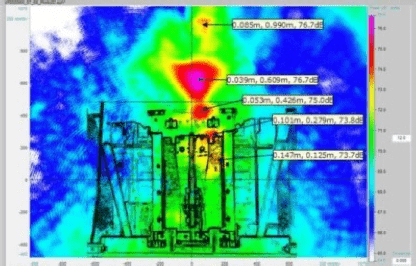The project DEMONSTRATE will investigatethe application of advanced instrumentation in the experimental testing performed. This instrumentation will include acoustic cameras, acoustic emissions techniques, thermography and Digital Image Correlation (DIC).

An acoustic camera is an imaging device used to locate sound sources and to characterize them. It consists of a group of microphones — also called microphone array — that are simultaneously acquired to form a representation of the location of the sound sources complemented by an optical camera. It allows the real-time monitoring of debonding processes and cracks in the structure being tested. As the sound of these failings propagates in the air at a finite known speed, the microphones perceive a sound source at different time instants and at different sound intensities that depend on both the sound source locations and the microphone locations. The damage locations are overlaid on the optical camera image using specific algorithms.
Acoustic Emissions is a well-known technique to detect the level of damage of a structure. It is also possible to identify the type of damage and its location, being a global monitoring technique. This technique is passive and consists of collecting the waves emitted by a defect at the time it is generated.

The technique of DIC was normally used qualitatively, due to the difficulties to quantify the important errors in measurements. One of the aims of the project is to introduce DIC as a tool for quantitative measurements. Standard DIC methodologies are currently well developed to provide qualitative full-field strain data, but their accuracy still needs to be improved, in order to systematically substitute strain gauges and displacement transducers. An additional issue is the lack of generally accepted or standard tools to perform a reliable DIC accuracy assessment and a quantification of its measurement uncertainty. Digital Image Correlation requires painting a speckle pattern on the surface of the monitored structure or gluing a printed pattern, and the dimensions of large structures require an optimal control of the applied pattern. This can induce the generation of image artefacts be confused as true material artefacts. In order to avoid such issues, the applied speckle pattern should be absolutely controlled and optimized with respect to the camera setup, field of view, measurement field and other measurement parameters.
During static or fatigue loading of metallic structures, cracks can initiate and grow at various sites. Optically excited thermography methods can reliably detect those defects and therefore play an important role in the investigation of safety-relevant components. Active thermography will be used in DEMONSTRATE, as an efficient method for rapid inspection of large areas of metallic and composite structures in a non-contact way.
With all the presented advanced instrumentation, and together with the Absolute Accurate Methodology Applus uses for getting the best possible boundary conditions for simulation purposes, the project DEMONSTRATE will without doubt represent an important advancement in the experimental testing industry.
